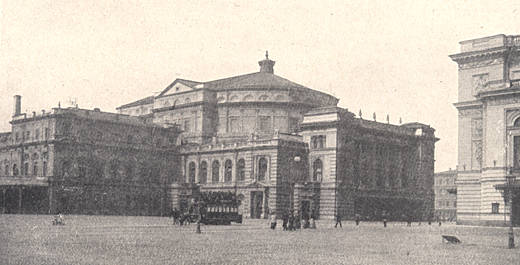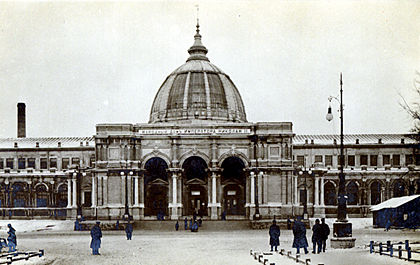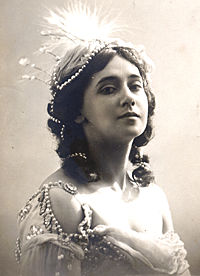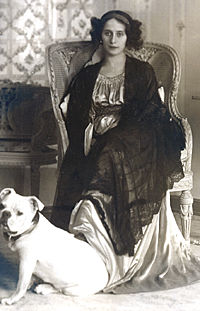   

 Left: One of Russia's world-famous wrestlers. Left: One of Russia's world-famous wrestlers.
Theater, music and entertainment was an important diversion to the people of St. Petersburg. There were all levels of entertainment from the performance of high-brow Italian Opera to car races and muscleman competitions. Fairs and street entertainment were an attraction.
The city had been the home of professional theatrical entertainment since it's founding. From the reign of Catherine the Great onwards famous artists from all over Europe made the long and grueling trip to St. Petersburg to perform for big fees. After the advent of rail travel the number of western European artists visiting Petersburg went up dramatically. Some decided to make the city their new home and trained new generations of Russian dancers, singers and actors. In the reign of Nicholas II a new theater was built called the "People's House" where subsidized performances were proudly given by the best Russian artists. The ticket prices were much lower at the People's House and hence more affordable to the general population of the city.
The "Season" in St. Petersburg began in the last two weeks of September when most people returned to the city. The nobility returned at the end of October at the same time as the Tsar and his family. This was the most brilliant part of the Season, and long-term visitors reported the city looked most brilliant and glorious during this freshing and exciting time of gala court balls, festivals and masquerades.
All of this revolved around the person on the Tsar, who was the most important
host, guest and critic. Nicholas I attended the theater almost everyday during the season and this continued to be true until the reign of Alexander III when he began to cut back the rulers attendance. His son Nicholas loved the theater (he wrote in his diary that nothing moved him more than music) and as Tsarevich he attended operas, ballets, plays and concerts as often as he could. He was extremely fond of Wagner and adored the German composer's operas, especially Tristan and Isolde. After he married his wife's frequent pregnancies and illnesses increasingly cut into his attendance. In 1900 the Imperial couple was still attending concerts and performances in the city, but they were becoming fewer and fewer each year.  Above: The People's House.
The famous Mariinsky Theatre, seen in the picture at the top of the page, went through several rebuildings over the years until it assumed this form in the middle 1800's. This luxurious building - designed by Albert Kavos went up in 1860. A few years later - in 1883 - it was extensively remodeled by Shreter .and more decoration was added to the facade to correct a plainness in the exterior. The Mariinsky center of the famous Imperial Ballet and Opera which was home to many of the most famous performing artists of the last 100 years. Many of the names of these stars are legendary - Nijinsky, Karsavina, Pavlova and many others. The artists of the Imperial theatre and the upkeep of its facilities was the responsibility of the Tsar and all of these costs came out of the annual revenues of the Imperial estates.
Tickets to the Mariinsky were hard to get in 1900. Most of them were pre-assigned to subscribers who held their seats for life. Boxes were very dear, when Prince Felix Yussupov married the Tsar's niece, Irina, the Tsar asked him what he wanted as a wedding present. Yussupov, a fan of the performing arts, asked for the right to use the Tsar's box at the theater when he was away - which was a gift beyond price. His request surprized and amused the Tsar who granted it. The Tsar's private box was on the left hand side of the Mariinsky stage and it had an incredibly intimate view of the stage, a dining room and it's own elegant bathroom. It also had its own private entrance to the building and staircase.
The famous ballerina, Tamara Karsavina has left us an account of life at the Mariinsky:
"The time of which I am speaking, the ballet company comprised about 180 persons, with a preponderance of women. The ranks were as follows: - corps de ballet, coryphies, second and first solo dancers and ballerinas. Salaries went according to rank. Promotions were given every spring and announced by the Journal of Orders, an official weekly gazette. The page of the journal dealing with the ballet troupe held a central position in a frame, together with announcements of rehearsals and other matters for general information. Every morning, artists, before entering the rehearsal-room, tarried on the landing to scan the page of the journal. Remonstrances, fines, honorable mention and scanty words of gratitude appeared on that page. With a feeling of great satisfaction, though I knew it already, I read the confirmation of my being received into the troupe as a coryphie on a raised salary of 720 roubles a year. It seemed a lot for the first year, as compared with the usual 600 of beginners. At home, my monthly 60 rubles made a welcome addition to the budget. As a matter of course I brought my money straight to mother; she gave me my fare every morning. It was all the pocket money I had. In consequence I never could buy anything, though I liked to look at the shop windows and sometimes wished for things, but without any bitterness or regret. I lived at that time in a complete unconcern of money, in a blissful poverty. The world gave me plenty; I felt myself a centre of it. My happiness took a pensive hue at times, but it was ever present.  Above: Tamara Karsavina.
The Marinsky Theatre invariably began the season by A Life for the Tsar, a patriotic opera. The first sunday of September the ballet opened. About a fortnight before the season the company assembled. The first day was more in the nature of a review of troops. We reported to the rigisseur and went home till a notice of rehearsal summoned such as were wanted. The whole service of notifying the company was carried out by five couriers attached to the staff. They usually went on foot, each working his assigned district. A telephone was not installed at the rehearsal-room until much later
My first part was in a group of solo dancers. I was put together with Pavlova, Siedova and Trefilova, then virtually ballerinas.
The tedious grind through which many a dancer went before reaching any prominence had been spared me. From the very beginning I was placed amongst the chosen. My career began under good auspices. The policy of the new director was favourable to the young; every opportunity, every encouragement were given to those who showed any promise. In the first year Lydia and I kept apace. We were paired in most of the parts. In some ballets, special dances were introduced to make us appear together, for the sake of the contrast. Each of us had her own enthusiastic crowd of theatrical admirers. When both on the stage together, the two camps joined forces, making a formidable noise, sometimes even to the annoyance of our elder comrades.
Theatre-Janus with two faces - your frown was yet hidden from me. Wise heads gave warning. An elder dancer, prominent on account of her wealth and connections, took a fancy to me. Nadejda Alexeievna never aspired to any fame. Indisputably elegant, she was well pleased to be in the first line of the corps de ballet. 'Do not be too confident,' she used to say to me. 'The theatre is a hotbed of intrigues. Why do you think she made you a present of this costume?' The costume in question I thought most beautiful and the gift most generous. 'Fancy you in dark mauve!' she went on. 'A pall for a coffin, not a costume for a child...'
There had been a period when, by the majority of the public, the ballet was regarded with scepticism and the lovers of it thought eccentric. Now, no longer the Cinderella of the stage, the ballet had become fashionable. A competition for seats, for the right to be a subscriber, well proved the interest it aroused. To obtain a seat, a petition to the Chancery of the Imperial Theatres had to be filed; the chance of success was so small that big premiums were constantly offered by advertisement to the original holders of the stalls. The subscribers held tenaciously to their prerogative. No outsider could ever penetrate into the first row of stalls without a Sesame, a favour of a balletomane friend. Even then, a new face would be looked upon as an intrusion and eyed suspiciously by the neighbours. The seats were handed down from father to son, the name of balletomane, once given in derision, was becoming almost an hereditary dignity. Having picked up the gauntlet, the balletomanes bore their name proudly. Whatever there may have been of personal motives in the attachment of some of them to the ballet, the cult of this delicate art was always uppermost.  Above: Anna Pavlova.
A very knowledgeable, exacting, somewhat dogmatic and conservative public, balletomanes were capable of high enthusiasm. They were conservative in the extreme. A new venture, the slightest variation from the old canons was heresy to them; an occasional modification of a step an irreverence as well as a disappointment. There were some favourite steps eagerly awaited. One could feel from the stage how the whole audience stiffened in breathless expectation of a favourite passage. The passage well executed, the whole theatre burst out clapping in measure to the music. Artistic reputations were made and undone by casual remarks of the leaders of the stalls. A foreign celebrity, in a series of performances, displayed a sound virtuosity. She was round shouldered. 'A flying turkey,' drawled Skalkovsky. His remark had been caught and repeated all round. They were a tyrannical public, those balletomanes, and pig-headed to a degree; if once they pronounced a dancer lacking some quality, no amount of evidence to the contrary would dispel the prejudice. They classified and ticketed the dancers as graceful, dramatic, lyrical, and did not encourage any attempt to develop qualities beyond those originally assigned. But they were enthusiastic. On no account would they miss a performance. When Mathilda Kshessinskaya went to dance at Moscow, the first row of stalls at the Marinsky emptied; her faithful had followed her.
Less pontifical, but hardly of smaller importance, were the lesser balletomanes, the pit and the gallery. They also crowned and dethroned. Erudition and the terminology of the ballet they may have lacked, but in spontaneity of admiration, in fanatical transports of young enthusiasm they far outstripped their colleagues of the stalls. While the stalls preserved a certain decorum, the gallery spared not their throats. Long after the stalls had emptied and the lights gone down in the auditorium, the gallery raved. The safety curtain crept down, dust sheets were brought in; the gallery still shouted. A last rite was to be performed yet waiting at the stage door. Manifestations at the stage door varied in proportion to the popularity of each artist. They ranged from silence to delirious outbursts. Sometimes a group of young people would follow their idol, keeping at a distance, a silent escort. Up in the gallery, or paradise as it was called, the admiration for artists was idealistic. The young generation showed an exaggerated mistrust of the smart set of the stalls. My comparative aloofness, which in the opinion of Nadejda Alexeievna might deprive me of a powerful support, was my best introduction to the favours of the gallery. It was repeated that I never went to suppers, and my reserve was glorified. The gallery made a pet of me. All this idealism and exuberance is not to be wondered at in young people. They were mostly students, schoolboys, young people of modest means. They had, though, their veterans and even a grandfather. When an address was to be presented by the gallery to an artist on a benefit night, the grandfather headed the deputation. He was a clerk in some Ministry, a shy, bearded little man in a neat uniform.
Only a certain number of seats in the gallery belonged to subscribers. The rest went on sale. The box office opened at eight O'clock in the morning. Even in the bitterest cold the queue round the theatre started overnight, though a ten hours' vigil by no means ensured a ticket. Eventually the ballet opened to wider circles, even nonsubscribers being occasionally able to gain admittance. Old balletomanes disapproved of this measure; they grumbled at missing a performance but would not demean themselves by going to other than subscription nights. At this time, however, the measure was not even anticipated; for a while yet the Chinese wall enclosing the ballet world-a very curious world with its own culture, its narrow range of interests, professional gossip, its wilful ignorance of intellectual progress stood unbreached.
Next photograph: The Imperial Conservatory of Music
For a small map of the St. Petersburg area click here.
To see a large map of the center
of St. Petersburg go here.
Comments on the website should be sent to Bob
Atchison.
|
 |
|

